

The language gives it away: How an algorithm can help us detect fake news. Have you ever read something online and shared it among your networks, only to find out it was false?
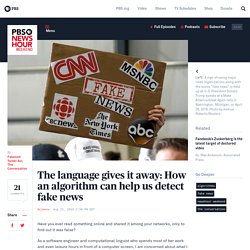
As a software engineer and computational linguist who spends most of her work and even leisure hours in front of a computer screen, I am concerned about what I read online. In the age of social media, many of us consume unreliable news sources. We’re exposed to a wild flow of information in our social networks — especially if we spend a lot of time scanning our friends’ random posts on Twitter and Facebook. My colleagues and I at the Discourse Processing Lab at Simon Fraser University have conducted research on the linguistic characteristics of fake news. The effects of fake news A study in the United Kingdom found that about two-thirds of the adults surveyed regularly read news on Facebook, and that half of those had the experience of initially believing a fake news story. Giveaways in writing style A second approach examines the writing style of a news article rather than its origin. Factitious. Jeu cuicuiter - trier, vérifier l'info.
Five Ways to Use Newspapers in the EFL Classroom. Army sergeant guilty of trying to kill wife by tampering with parachute. Eu.usatoday. Journalism Competition for Your Classes. To celebrate the Semaine de la Presse à l’école, we’d like to turn your pupils into reporters.
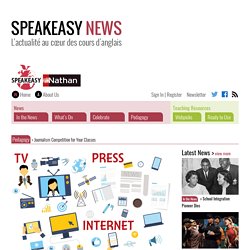
We’re inviting them to write their own articles to send us and we’ll publish our favourites on Speakeasy-News. The theme of the competition is “School Report”. The objective is for pupils not to be tempted to cut and paste from the Internet, but to actively find information and then report it. To keep that simple, it should be news from their class or their school. (At a push from their town). We were inspired by the BBC’s long-running school journalism project School Report.
The BBC project is mainly about TV and radio news but we would like pupils to produce a written article (for a newspaper, magazine or website, the main elements are the same.) The subject is up to you and your pupils. Our Class and the News The theme this year for the semaine de la presse is “Where does the news come from?” The common elements they should be able to identify (and include in their article) are: Copyright(s) :
Online Language lessons. Fake news – a lesson plan. Fake news, post-truth, and alternative facts are three buzz terms that seem to sum up this strange time we live in.
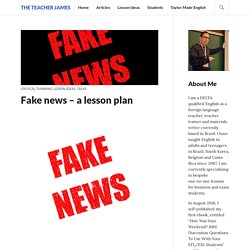
It’s something that fascinates me, and as a language teacher I feel that I’m in a position where I can not only discuss this with my students of all ages, but also help them to become more critical in how they interact with the news that comes their way. This is essentially what I have been arguing in my talk English Teaching in the Post-Truth Era which so far I have done at conferences in Brazil, the UK and Belgium. In order to support the talk I have prepared a lesson plan to be used with teen and adult students, as well as many of the resources and articles I mention in the talk. The lesson is designed to introduce students to the notion of fake news and teach them some strategies to become better, more critical readers.
It is adapted from a lesson plan by the Anti-Defamation League (link) with elements taken from here. To Test Your Fake News Judgment, Play This Game : NPR Ed. Fake news has been on Maggie Farley's mind further back than 2016 when President Trump brought the term into the vernacular.
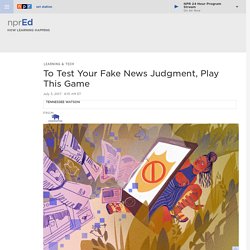
Farley, a veteran journalist, says we've had fake news forever and that "people have always been trying to manipulate information for their own ends," but she calls what we're seeing now "Fake news with a capital F. " In other words, extreme in its ambition for financial gain or political power. "Before, the biggest concern was, 'Are people being confused by opinion; are people being tricked by spin? ' " Now, Farley says, the stakes are much higher. Fake It To Make It.
Factitious. EMI-EMC : comment envisager la désinformation ? - Histoire-géographie - Éduscol. L’actualité autour des fake news et leur prise en charge par les différents systèmes politiques dans des sociétés de l’information dans un contexte de mondialisation devient un thème central des mises en œuvre de l’EMI et de l’EMC.
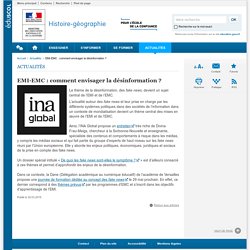
Ainsi, l’INA Global propose un entretien très riche de Divina Frau-Meigs, chercheur à la Sorbonne-Nouvelle et enseignante, spécialiste des contenus et comportements à risque dans les médias, y compris les médias sociaux et qui fait partie du groupe d’experts de haut niveau sur les fake news réuni par l’Union européenne. Elle y aborde les enjeux politiques, économiques, juridiques et sociaux de la prise en compte des fake news. Fact-checking : notre kit de survie en 5 gestes qui sauvent (partenariat avec le CFJ) Démêler l'info de l'intox sur Internet - LeWebPédagogique. Chasseur d'infos. Relier Colonnes Five ways to spot fake news. technology. Isabe... How false news can spread – TED4ESL – Your place for ESL materials.